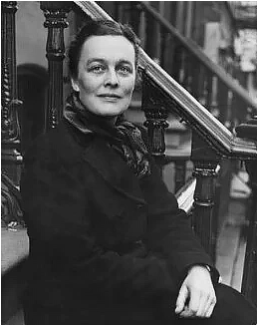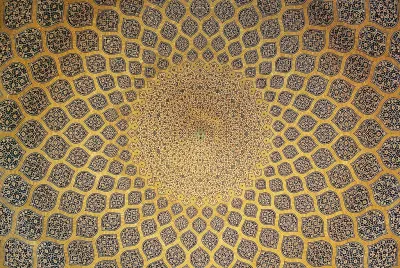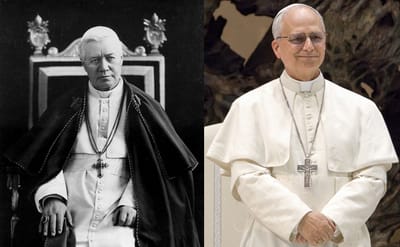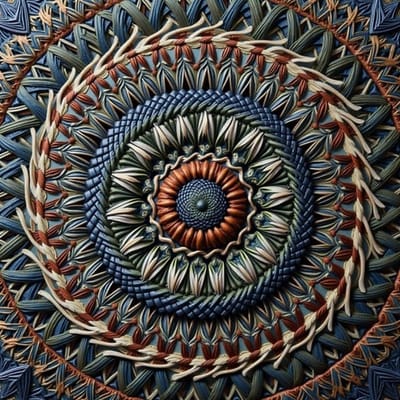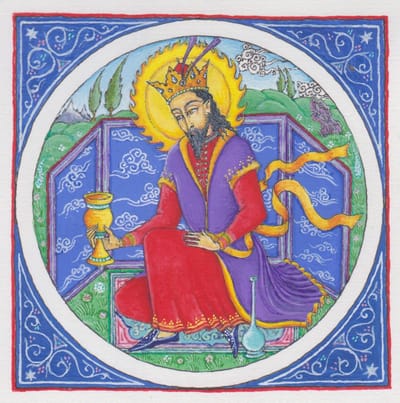Against the nihil
One candle flame, one blade of grass
One thought suffices
To affirm all.[[1]]
Kathleen Raine discovered her vocation as a poet as a young child. Her father was an English teacher and a lay Methodist preacher while her mother was immersed in the Scottish tradition passed down in ‘song, speech and heroic story’. During the Great War young Kathleen lived with her aunt in a small hamlet in Northumberland which became ‘her touchstone of wild beauty, simplicity and innocence’,[[2]] an experience she later described in her autobiography: ‘I loved everything about it. In Northumberland I knew myself in my own place; and I never “adjusted” myself to any other or forgot what I had so briefly but clearly seen and understood and experienced’.[[3]] It was to be the wellspring of her poetry along with Scotland where ‘poetry was [still] the essence of life’ Among the early literary influences were the Bible, Shakespeare, Romantic poetry (especially Wordsworth), and Scottish ballads.
Raine is best known as a poet and a creative Spirit but my primary concern in this note about her is with her thought, with her exposition of traditional ideas and the sophia perennis which became increasingly central in her later life. But before that, I record a few more biographical fragments:
- the allure of the natural world in her childhood and the influence of her father’s literary enthusiasms and her mother’s love of the oral traditions of Scotland
- the study of natural sciences at Girton College, Cambridge (although an aspiring poet, she was not attracted to the academic study of literature; Academe was ‘Satan’s last and subtlest temptation of the poet’[[4]])
- the first publication of her poems[[5]]
- an early, unhappy and short-lived marriage, followed by a second marriage which yielded two children
- a precarious livelihood based on part-time teaching, book reviewing and translation work
- several tempestuous and ill-fated affairs, including an intense but disastrous relationship with the naturalist-writer Gavin Maxwell, the love of her life but its erotic potential thwarted by his gayness.[[6]]
After the break-up with Maxwell, Raine seems to have renounced romantic relationships, and assessed her young adulthood with ‘ruthless severity’; she described herself in young adulthood as ‘a neurotic bohemian’ seduced by the materialism and a nihilism which pervaded Cambridge.
She now turned her creative energies to poetry and scholarship which, in its earliest phase, focused on the great English visionary, artist and poet, William Blake, on whom Raine established herself as an authority, albeit a controversial one. Blake remained her pole-star for many years and Raine published several books about him. The definitive work is Blake and Tradition (1969) which, C.S. Lewis declared, made all previous studies obsolete. In that work Raine rescued Blake from the conventional picture of a semi-crazed and highly idiosyncratic artist, showing how he was rooted in a tradition stretching back to Plato. She also wrote extensively on Thomas Taylor, Wordsworth, Coleridge and W.B. Yeats (‘the singing master of the soul’) as well as completing translations of Balzac and other French authors.
Raine repudiated modernist-experimentalist-avant garde fashions and ideological agendas in both her poetry and criticism.
Believing as I do that poetry is in its proper nature the language of the soul; that its proper function is to create for us images of an inner order all share, to open into every present those secret doors, those ways in; to consecrate and redeem for every generation some parcel of the surrounding waste, I cannot feel that those poets of the thirties, brilliantly and admirably as they may have performed some other social role, were fulfilling the proper and vital task of poetry.[[7]]
Over the years she was to write on a wide range of poets, most of them ignored or disparaged by the literary Establishment: Gerard Manley Hopkins, Edwin Muir, Vernon Watkins, David Gascoyne, David Hopkins, and St. John Perse. The title of one her critical collections, Defending Ancient Springs (1967), is suggestive of her interests and proclivities.
Throughout her life she continued to write poetry, publishing over a dozen volumes, starting with Stone and Flower in 1943. Raine also wrote a three-volume autobiography and a late book about her discovery of India (first visited in the 70s, and three times thereafter), especially its philosophical and religious traditions.[[8]]
What of her personal qualities? One account: ‘She always lived by her own lights. Haughty, imperious, almost royal in her bearing, she was formidable’.[[9]] She had no high opinion of many contemporary writers, evident, for instance, in her dismissal of Anthony Burgess and iris Murdoch as ‘journalists’. (Time may prove her right!) The same writer described her as striking some people as ‘authoritarian, remote, aristocratic, patrician, unapproachable’ but spoke also of her ‘ultimate generosity’ in devoting her life to enriching the spiritual lives of others.
Her own religious moorings shifted several times: from the Methodism in which she was raised, to Roman Catholicism, to Platonism and the philosophies of the East, ultimately resolving these ostensible tensions through her deepening understanding of the sophia perennis.
‘…in time of trouble, I kept the divine vision’
Of her poetry, one of her friends and collaborators, Brian Keeble, has written this:
From the beginning Kathleen Raine’s poetry combined a singular clarity of sight and diction with a voice distinctly her own in which the forms of nature are seen with a directness that is without conventional sentiment yet coupled with an affinity of mood and an intimacy of imaginative vision that penetrates to the numinous core of natural forms. This imaginative perspective, whose nature preserves the vestiges of an Edenic, prelapsarian innocence, set her apart from the modernist agenda, with its readiness to innovate and adopt the materialist values of the contemporary, secular culture. This was for her an occlusion of vision rather than an extension of imaginative response.[[10]]
Raine won many honorary degrees and awards including the Queen’s Medal for Poetry, Commander of the Order of the British Empire, and Commandeur of the Ordre des Arts et des Lettres, an honour which especially gratified her, a lifelong Francophile.
When asked how she would like to be remembered she recalled Blake’s response to the same question: ‘That in time of trouble, I kept the divine vision'.
She died in London after being knocked down in the street by a reversing car, breaking her hip and subsequently catching pneumonia. She was 95.
In later life Raine became increasingly preoccupied with the preservation of the sophia perennis, the Wisdom of the Ages which she discerned in the mythological, religious and poetic/folkloric traditions of both the East and the West. Her work on Blake, initially influenced by Jungian ideas, and her later writings on Yeats, demonstrated her close familiarity with Hermetic, Platonic and neo-Platonic, and Vedantic philosophy. In mid-life her outlook was redirected and refined by the work of René Guénon to which she had been introduced by Philip Sherrard, one of her collaborators in an enterprise to which she devoted herself in the last two decades of her life: the journal Temenos and the subsequent establishment of the Temenos Academy, a forum for the repudiation of the ‘Single Vision’ which tyrannized the modern outlook and the reaffirmation of the traditional outlook and its attendant spiritual values.
In November 1986 a group of artists, writers and scholars gathered in South Devon for the First Temenos Conference on the theme ‘Art and the Renewal of the Sacred’. Among the attendees who were to play a crucial role in the subsequent establishment of the Temenos Academy were Raine, Keith Critchlow (architect and geometer), Brian Keeble (publisher and author), and Philip Sherrard (Orthodox perennialist, author and Graecophile). These four subsequently became the editors of the Temenos Academy Review, a successor to the Temenos journal in which they had all been involved since its appearance in 1980. A blurb for the 1986 Conference announced its agenda:
… to reaffirm and redefine the function of the arts as the mirror of the human spirit. In the present situation society is suffering from the loss of any value-system which corresponds to our true needs and nature, and a new examination of the fundamental principles of life is of vital importance. From time immemorial the arts have been the medium for the expression and spreading of the human vision of the sacredness of life. At present the finer values in society have succumbed to the reductionist and materialist ideologies which threaten our very survival.[[11]]
Apart from those already mentioned, speakers at the conference included Wendell Berry, Jocelyn Godwin, Satish Kumar and Yoshikazu Iwamoto. The Academy was formally established in 1991 under the patronage of the Prince of Wales (now King Charles III) who generously provided Raine with a workplace, a suite of rooms in his Institute of Architecture. The Academy continues to present courses in the perennial philosophy which ‘runs like a golden thread through history and offers each generation contact with the values that nourish all civilizations’ (except, it hardly need be added, our own). The Academy also sponsors public lectures and exhibitions, maintains the Review, and has a close association with the Prince’s School of Traditional Arts. The Temenos website welcomes readers with Raine’s verse, ‘Against the nihil’ reproduced as the epigraph for this essay. The Temenos Academy and its journal remain a conspicuous part of Raine’s enduring legacy.
We might note in passing that Sherrard later mounted quite a severe critique of Kathleen Raine’s understanding of the psyche and what he saw as her over-valuation of the Imagination.[[12]] Sherrard’s critique also exposes some other divergences in their respective understandings of the perennial philosophy as espoused by Guénon, Schuon et al. Raine does not seem to have been unduly upset by his criticisms. After his death she wrote a generous and eloquent tribute to Sherrard.[[13]]
William Blake’s words, ‘everything that lives is holy’ [is] our sacred trust
Raine’s work in her later years was always addressed to the fundamental spiritual malaise of modernity and to its remedy in the ‘ancient springs’ of Tradition.
There are but two alternatives. The first alternative is that of secular materialism – appealing to the authority of a science whose only reality is the measurable – ‘nothing is sacred’ – and no bounds set to destructive exploitation. The second alternative – embraced in every tradition of wisdom – holds that man and nature alike are a manifestation of immeasurable spirit. If that is so, we are custodians of a world in which, in William Blake’s words, ‘everything that lives is holy’ and our sacred trust.[[14]]
‘Man and nature alike’ might be taken as a key to Raine’s vision. It is by experientially ‘knowing’ the natural world that we recognize the correspondences between the created order and ourselves and thus come to know our own ‘boundless selves’ as inseparable from the ‘immeasurable spirit’. Nature was a sacred text, a theophany.
I’ve read all the books but one
Only remains sacred: this
Volume of wonders, open
Always before my eyes.
A profane materialistic science is not only of no help but is a barrier to any awakening to the Real (in whatever terms we might describe it).
For Raine the way forward was a way back: a return to those modes of understanding and those values which informed traditional societies, and which were still preserved in arts and crafts where the practitioners had not surrendered to the spiritually corrosive fashions of modernity, artists still in search of the True, the Good and the Beautiful.
In a late essay she posed a troubling question:
Poets of the imagination write of the soul, of intellectual beauty, of the living spirit of the world. What does such work communicate to readers who do not believe in the soul, in the spirit of life, or in anything that can be called “the beautiful”?[[15]]
While Raine was tireless in her affirmations of the sophia perennis she was not unaware of the cyclic conditions to which Guénon had alerted the world in The Reign of Quantity (1945), the ‘Latter Days’, the Kali Yuga, in which we find ourselves. One of her late poems which she deliberately placed last in The Collected Poems of Kathleen Raine, was ‘Milennial Hymn to the Lord Shiva’, which, as Brian Keeble has noted,
made final use of another traditional motif that informed much of her work – that of the Kali Yuga – and spoke with a prophetic urgency of how our time, witness to the death of culture and therefore of the immemorial patterns of human life shaped at all levels by a vision of the sacred nature of reality, must take its part in the greater cycle of creation and destruction that is at once ‘the unknowable mystery’ and the ‘holy fire’ that liberates and purifies.[[16]]
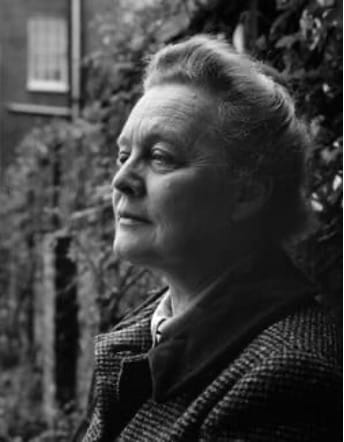
Principal Sources
For Raine’s autobiographical writings see the trilogy Farewell Happy Fields (1974), The Land Unknown, (1975), The Lion’s Mouth (1977), and the stand-alone India Seen Afar (1990). A comprehensive collection her poetry can be found in The Collected Poems of Kathleen Raine (Cambridge: Golgonooza Press, 2019). The most crucial of her scholarship can be found in Blake and Tradition, Defending Ancient Springs and a posthumous compilation edited by Brian Keeble, The Underlying Order and other essays, (London: Temenos Academy, 2008). For a collection of essays and tributes see Lighting a Candle: Kathleen Raine and Temenos, Temenos Academy Papers 25 (London: Temenos Academy, 2008). (There is also a biography which I have not seen: Philippa Bernard, No End to Snowdrops: A Biography of Kathleen Raine, 2010.)
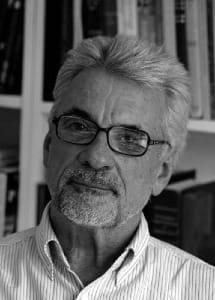
Harry Oldmeadow is an Australian academic, specializing in the writings of the Traditionalist School. His interests include Native spirituality and he is a commentator on modernism.
[[1]]: This essay is excerpted from Persons of Interest: People, Books, Ideas, Encounters, Carbarita Press, 2023
[[2]]: Janet Watts, Obituary, The Guardian, 8th July, 2003 (on-line)
[[3]]: Farewell Happy Fields, 1973
[[4]]: From Raine’s review of Edwin Muir’s The Estate of Poetry in Comment, January 1963. Raine believed, unfashionably, that Muir (1887-1959) was the foremost poet of his generation
[[5]]: William Empson published her poems in Experiment. Raine surmised that he had done so because he found her pretty. Who knows!
[[6]]: For a brief account of her relationship with Maxwell, see Lyndsey Jenkins, ‘“But why this here and now only when I loved I knew”: Remembering Kathleen Raine’, June 14, 2022; womenshistorynetwork.org
[[7]]: ‘Waste Land, Holy Land’, The Warton Lecture on English Poetry, 1976, (The British Academy website), 387
[[8]]: The autobiographical volumes are Farewell Happy Fields (1974), The Land Unknown, (1975), The Lion’s Mouth (1977), and a stand-alone book, India Seen Afar (1990). Her autobiographical volumes met with a good deal of critical flak. Ray Monk, for instance, dismissed them in the Times Literary Supplement as being riddled with ‘transcendental twaddle’. For a short account of Raine’s views about the significance of the sub-continent see her lecture ‘India and the Modern World’ (New Delhi, 1989) in The Betrayal of Tradition: Essays on the Spiritual Crisis of Modernity, edited Harry Oldmeadow, 2005, 45-51
[[9]]: Obituary, The Scotsman, 17th July, 2003 (on-line)
[[10]]: Brian Keeble, “Kathleen Raine (1908-2003)”, Sacred Web (on-line)
[[11]]: Temenos Academy website (on-line)
[[12]]: See Philip Sherrard, “Kathleen Raine and the Symbolic Imagination”, Temenos Academy Review 11, 2008, 180-208. See also Jack Herbert, “Philip Sherrard on ‘Kathleen Raine and The Symbolic Art’: Some Reactions and Thoughts”, Temenos Academy Review 12, 2009, 238-247. x
[[13]]: Kathleen Raine, Philip Sherrard: A Tribute, 1996. (This 20-page piece was available on Amazon for no more than $102 but is now apparently out of print.)
[[14]]: www.temenosacademy.org/kathleen-raine/
[[15]]: Raine quoted in Huston Smith, Beyond the Postmodern Mind, 1982, 82.
[[16]]: Brian Keeble, “Kathleen Raine (1908-2003)”, Sacred Web (on-line)

